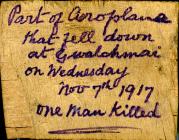Content can be downloaded for non-commercial purposes, such as for personal use or in educational resources.
For commercial purposes please contact the copyright holder directly.
Read more about the The Creative Archive Licence.
Description
This aerial photograph is from the Medmenham Collection which dates from 1940 onwards and is made up of 1,000s of military intelligence photographs taken during reconnaissance flights by pilots in unarmed planes. This one of Llandow airfield was taken on the 3 August, 1944 by the United States Air Force.
In the photograph, faint dark lines can be seen across the runways - these were drawn with creosote to create 'mock hedges' to disguise the airfield against enemy attack. By the time of this photograph (1944), german bombing raids had stopped and the lines had been allowed to fade.
One of over 60 military air fields in Wales, the Llandow site had been used as an grass strip airfield with a few wooden buildings from 1937. Its main period of wartime use began on 1 April 1940 as an Aircraft Storage Unit (ASU) run by 38 Maintenance Unit (MU). One L-type hanger was initially built to house the first Westland Lysanders, De Havilland Tiger Moths, Fairy Battles, Fox Moths and Bristol Blenheims. The runways were completed in the Autumn on 1941. Eleven Super Robin hangers and a further seven L-type hangers were rapidly built. As more aircraft arrived for storage (up to 856 by November 1945), a further two K-types, one J-type, two T2s, and one A1 hangar were added with 12 Blisters.
After the war, the A flight of 633 Squadron were also based here between July 1949 and March 1957. The airfield continued to be used as a storage satellite for RAF St Athan, until the length of its runways made it unsuitable for the heavier jetfighters entering service.
Used as a dispersal site for aircraft that were no longer needed after the end of the Second World War, Llandow coped with significantly more aircraft than expected for such a small establishment. By 1946 some 856 airframes were waiting to be scrapped, including bombers such as the Lancaster, Halifax, and Wellington, plus large numbers of Mosquito and Beaufighter fighter-bombers. Even iconic Spitfires could not escape being broken up for scrap.
The defences around the airfield included Picket-Hamilton forts. All the original buildings remain intact and are used for storage behind security fencing. The type 518/40 pattern control tower is now used as offices. The main runway forms a public road, with the B4270 using part of the perimeter track. A go-cart circuit also uses parts of the runways and the perimeter track.
In August 2012 the airfield was the site of the National Eisteddfod.
For more information see: http://medmenhamcollection.co.uk/site2012/collection/trustees/advice.htmlDefe
Defence of Britain Project
Jones, I, 2007, Airfields and Landing Grounds of Wales: South, pg107-120
Phillips, Alan, 2006, Military Airfields Wales, pg 122-128 Smith, David J 2982 Action Stations 3: Military Airfields of Wales and the North West, pg 115-6
Photo Ref: 4002






Do you have information to add to this item? Please leave a comment
Comments (0)
You must be logged in to leave a comment